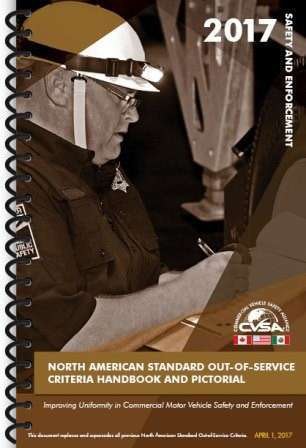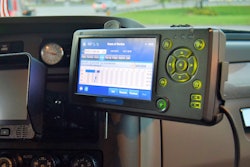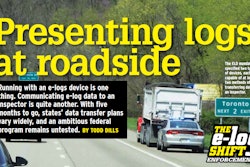Previously in this series: Presenting logs with ELDs at roadside
 CVSA’s 2017 out-of-service criteria handbook
CVSA’s 2017 out-of-service criteria handbookThe Commercial Vehicle Safety Alliance’s announcement of the availability of the updated out-of-service criteria handbook noted amendments related to electronic logging devices. Unlike previous updates, however, the alliance didn’t publicly spell out the details of those additions.
Closer examination of the book itself reveals that none are new OOS conditions. Rather, they’re footnotes related to current OOS conditions having to do with the hours of service, namely having no log book, having no previous seven days of logs and presenting a false log. All require putting the driver OOS for 10 consecutive hours (8 for passenger-carrying drivers).
- If a driver/carrier isn’t using an ELD on FMCSA’s device registry, it’s considered to be having no log book. There’s a wrinkle in this, though, given FMCSA’s grandfather period for current-generation automatic onboard recording devices. AOBRDs meeting fairly minimal requirements compared to ELD specs are essentially grandfathered through Dec. 16, 2019. The ELD mandate notes that any carrier installing an AOBRD prior to this year’s ELD enforcement date can use that device until the 2019 date. Practically, what that means is that enforcing the requirement to use a registry-listed device is unlikely before that time, particularly for carriers that comply with the ELD rule as it currently stands and install an engine-connected e-log prior to Dec. 18. (If the rule’s deadline ends up being delayed, this could change.) So the registry’s importance for carriers choosing ELDs at this stage is minimal. If placed OOS for this one prior to 2019, and you have proof you were using an ELD/AOBRD prior to Dec. 18 this year, this could be cause for a challenge to remove it from your record.
- A driver “unable to produce or transfer the data” from an AOBRD or ELD at roadside will be considered to have no log and be placed OOS.
- If you use a special driving category – a yard move or personal conveyance, for example – “when not involved in that activity,” you’re considered to have a false log.
- In the event of AOBRD/ELD failure, inability to reconstruct the previous seven days of logs will net you an hours violation for not having the logs. Fortunately, in failure cases, if you’re a true independent with authority and you have access to the web at roadside, with most ELD platforms you’ll be able to access your logs to either email to an officer or print to carry with you down the road in case of an inspection. Keep a paper log in the truck for on-the-spot malfunction backups for that current period. If you’re leased or a company driver, it’s not uncommon that drivers in such situations move to a paper log for their current period and have their required previous seven days’ logs emailed to them or an officer.
- Failure by a carrier to “repair a malfunctioning electronic logging device within eight days,” as required by the mandate, or to obtain an extension from FMCSA will net a no-log book OOS.
- Failure by a driver to use the ELD like it’s supposed to be used (logged in with your driver profile) merits a no-logbook OOS.
- If you’re not an exempted carrier or driver under the terms of the ELD mandate and you’re not using an ELD, you’ll be considered to have no log book.
In terms of your company safety record, your own if you’ve got authority, having no log comes with a 5 (out of 10) severity weight in the Compliance, Safety, Accountability Safety Measurement System – not publicly available at the moment, but still impactful in some business relationships. OOS violations in the CSA SMS’ scoring methodology also receive extra weight – 2 more points.
NEXT:









